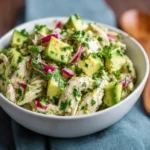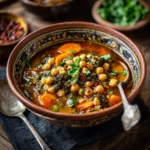Spaghetti Squash Pad Thai: A Healthy, Flavor-Packed Twist on a Classic
If you’re looking for a lighter, nutrient-rich alternative to traditional Pad Thai, look no further than this Spaghetti Squash Pad Thai. This innovative dish swaps out rice noodles for roasted spaghetti squash strands, offering a gluten-free, low-carb option that doesn’t skimp on flavor. Packed with vibrant vegetables, protein, and the signature tangy-sweet-spicy sauce of authentic Pad Thai, this recipe brings all the beloved elements of the classic Thai street food favorite into a wholesome, modern meal perfect for health-conscious foodies or anyone seeking comfort with a nutritional upgrade.
The History of Pad Thai — And How Spaghetti Squash Became a Star
Pad Thai is one of Thailand’s most iconic dishes, believed to have been popularized in the 1930s under Prime Minister Plaek Phibunsongkhram as part of a national campaign to promote rice noodles and unify Thai identity through food. Traditionally made with soaked rice noodles stir-fried with eggs, tofu, shrimp or chicken, bean sprouts, peanuts, and a rich tamarind-based sauce, Pad Thai quickly gained international acclaim for its bold balance of sweet, sour, salty, and umami flavors.
In recent years, as dietary preferences shifted toward plant-based, low-carb, and grain-free lifestyles, home cooks and chefs began experimenting with noodle alternatives. Enter spaghetti squash — a winter squash known for its stringy, noodle-like flesh when cooked. Native to North America and cultivated for centuries by indigenous peoples, spaghetti squash gained mainstream popularity in the U.S. during the 20th century. Its mild flavor and impressive texture make it an ideal stand-in for pasta, especially in Asian-inspired dishes like this Pad Thai reinvention. By combining the cultural richness of Thai cuisine with the practicality of seasonal produce, Spaghetti Squash Pad Thai represents a delicious fusion of tradition and innovation.
Ingredients Breakdown: What Makes This Dish Shine?
This recipe is carefully crafted to deliver both authenticity and nutrition. Let’s break down each component:
- Spaghetti Squash: The star of the show. When roasted, its flesh separates into long, tender strands resembling spaghetti. Low in calories and carbohydrates, high in fiber, vitamin C, and antioxidants, it forms the perfect base.
- Tamarind Paste: Essential for authentic Pad Thai flavor. Tamarind delivers a deep, tangy sweetness that defines the dish. If unavailable, a mix of lime juice and brown sugar can substitute.
- Fish Sauce: Adds savory umami depth. For a vegan version, use soy sauce or tamari (gluten-free option).
- Coconut Aminos: A soy-free, gluten-free alternative to soy sauce with a slightly sweeter profile, ideal for those with sensitivities.
- Brown Sugar or Coconut Sugar: Balances acidity and enhances caramelization. Use raw honey or maple syrup for different nuances.
- Garlic & Ginger: Provide aromatic heat and immune-boosting properties.
- Scallions, Red Bell Pepper, Carrots: Add color, crunch, and a boost of vitamins A and C.
- Snap Peas or Bean Sprouts: Fresh, crisp textures that mimic traditional Pad Thai ingredients.
- Eggs or Tofu: Protein options — scrambled eggs add richness; firm tofu offers a vegan-friendly bite.
- Shrimp, Chicken, or Tempeh: Optional proteins for heartier versions.
- Lime Wedges: Brightens the final dish with citrus zing.
- Chopped Peanuts: For nutty crunch and traditional garnish.
- Red Pepper Flakes or Sriracha: Adjust heat to taste.
- Cilantro: Fresh herb that lifts the entire flavor profile.
- Avocado Oil or Coconut Oil: High-heat cooking oils with clean flavor and beneficial fats.
Step-by-Step Recipe: Crafting Your Spaghetti Squash Pad Thai
Step 1: Roast the Spaghetti Squash
- Preheat your oven to 400°F (200°C).
- Carefully cut one large spaghetti squash (about 3–4 lbs) in half lengthwise using a sharp knife. Be cautious — the skin is tough!
- Scoop out the seeds and stringy pulp with a spoon (save the seeds for roasting if desired).
- Drizzle the cut sides lightly with avocado oil and season with a pinch of sea salt.
- Place the halves cut-side down on a parchment-lined baking sheet.
- Roast for 35–45 minutes, until the flesh is tender and easily pierced with a fork.
- Remove from oven and let cool slightly. Once safe to handle, use a fork to scrape the inside of each half, pulling out the long, spaghetti-like strands. Set aside.
Step 2: Prepare the Pad Thai Sauce
In a small bowl, whisk together:
- 3 tablespoons tamarind paste
- 2 tablespoons fish sauce (or soy sauce/tamari for vegetarian)
- 2 tablespoons coconut aminos
- 1 tablespoon brown sugar or coconut sugar
- 1 tablespoon lime juice
- 1 clove garlic, minced
- 1 teaspoon fresh ginger, grated
- ½ teaspoon red pepper flakes (optional)
Set the sauce aside. Taste and adjust — more sugar for sweetness, more lime for tartness, more fish sauce for saltiness.
Step 3: Sauté the Aromatics and Vegetables
- Heat 1–2 tablespoons of avocado oil in a large wok or non-stick skillet over medium-high heat.
- Add 2 cloves of minced garlic and 1 tablespoon grated ginger. Stir for 30 seconds until fragrant (don’t burn!).
- Add 1 diced red bell pepper, 1 shredded carrot, and 1 cup snap peas. Stir-fry for 4–5 minutes until crisp-tender.
- If using protein, add now:
- Eggs: Push veggies to one side, crack 2 eggs into the pan, scramble, then mix in.
- Tofu: Add 1 cup cubed, pan-seared extra-firm tofu.
- Shrimp/Chicken: Add 1 cup cooked, sliced protein and warm through.
Step 4: Combine and Simmer
- Pour the prepared Pad Thai sauce into the skillet. Stir well to coat the vegetables and protein.
- Add the roasted spaghetti squash strands. Gently toss everything together using tongs or two spoons to avoid breaking the squash.
- Cook for 3–5 minutes, allowing the sauce to absorb into the squash and flavors to meld. Avoid overcooking, which can make the squash mushy.
- Taste and adjust seasoning — you may want a splash more lime juice or a pinch more sugar.
Step 5: Garnish and Serve
Transfer to serving plates. Top generously with:
- Fresh cilantro leaves
- Sliced green onions
- A squeeze of fresh lime juice
- Crushed roasted peanuts
- Extra red pepper flakes for heat
- Bean sprouts for crunch (if available)
Serve immediately while warm and aromatic.
Expert Tips for Perfect Spaghetti Squash Pad Thai
- Don’t Overcook the Squash: Roast just until fork-tender. Over-roasting leads to watery, mushy strands.
- Dry the Squash After Roasting: If the squash seems too moist, spread it on a clean kitchen towel or paper towels to absorb excess moisture before stir-frying.
- Use a Wok for Authentic Texture: The high heat and curved surface allow for quick, even cooking without steaming the ingredients.
- Prep Ahead: Roast the squash up to 2 days in advance and store in the fridge. Saves time on busy weeknights.
- Boost Umami: Add a teaspoon of mushroom powder or a dash of liquid aminos for deeper savory flavor.
- Keep It Crisp: Don’t overcrowd the pan — cook in batches if doubling the recipe.
- Balance the Sauce Early: Always taste your sauce before adding it to the dish. It should be a harmonious blend of sweet, sour, salty, and spicy.
- Vegan? Double-Check Ingredients: Ensure fish sauce is replaced and sugar is plant-based (some brown sugars use bone char).
Variations and Customizations
This recipe is incredibly versatile. Try these creative twists:
- Zoodle Version: Swap spaghetti squash for spiralized zucchini noodles (add at the very end to prevent sogginess).
- Thai Basil Infusion: Stir in fresh Thai basil leaves at the end for a floral, anise-like note.
- Mango Addition: Add diced ripe mango for tropical sweetness that complements the tangy sauce.
- Curry Twist: Mix in 1 teaspoon red or yellow curry paste to the sauce for a fusion kick.
- Nut-Free Option: Replace peanuts with toasted sunflower seeds or omit entirely for allergies.
- Keto-Friendly: Reduce sugar, use erythritol or monk fruit sweetener, and increase healthy fats with avocado slices.
- Meal Prep Friendly: Assemble components separately and combine when reheating. Store sauce separately to maintain texture.
- Breakfast Pad Thai: Add extra eggs, swap squash for sweet potato noodles, and top with a fried egg.
Health Considerations and Nutritional Value
One of the biggest advantages of Spaghetti Squash Pad Thai is its superior nutritional profile compared to traditional versions.
Nutrition Highlights (Per Serving, Approximate):
- Calories: 320–380 (vs. 600+ in restaurant Pad Thai)
- Carbohydrates: 45g (with squash), but with higher fiber and lower glycemic impact than rice noodles
- Fiber: 8–10g (supports digestion and satiety)
- Protein: 12–18g (depending on added protein)
- Fat: 12–15g (mostly heart-healthy unsaturated fats from oil and nuts)
- Vitamins: Rich in Vitamin A (from carrots, squash), Vitamin C (bell peppers, lime), and B-vitamins (eggs, fish sauce)
- Minerals: Good source of potassium, magnesium, and iron
Health Benefits:
- Low Glycemic Index: Spaghetti squash has a GI of ~30, making it suitable for diabetics and blood sugar management.
- Gluten-Free & Grain-Free: Ideal for celiac disease, gluten sensitivity, or paleo/keto diets (with modifications).
- Antioxidant-Rich: Carotenoids in squash and bell peppers help fight oxidative stress.
- Gut Health: High fiber content promotes a healthy microbiome.
- Heart-Healthy: Unsaturated fats, low sodium (when controlled), and no trans fats.
Dietary Notes:
- Vegan/Vegetarian: Use tofu, tempeh, or edamame; replace fish sauce with soy sauce or tamari.
- Nut Allergies: Omit peanuts; use seeds or additional tofu for texture.
- Low-Sodium: Use reduced-sodium soy sauce or coconut aminos and limit added salt.
- Pregnancy-Safe: Fully cook eggs and proteins; ensure all produce is washed thoroughly.
Full Ingredient List
- 1 large spaghetti squash (3–4 lbs)
- 2 tbsp avocado oil or coconut oil (divided)
- Sea salt to taste
- 3 cloves garlic, minced (divided)
- 1 tbsp fresh ginger, grated
- 1 red bell pepper, thinly sliced
- 1 large carrot, julienned or shredded
- 1 cup snap peas or snow peas
- 2 large eggs, beaten (optional)
- 1 cup cooked protein (tofu, shrimp, chicken, etc.)
- 3 tbsp tamarind paste
- 2 tbsp fish sauce (or soy sauce/tamari)
- 2 tbsp coconut aminos
- 1 tbsp brown sugar or coconut sugar
- 1 tbsp fresh lime juice
- ½ tsp red pepper flakes (or to taste)
- ¼ cup chopped fresh cilantro
- 3 green onions, sliced
- ¼ cup crushed roasted peanuts
- Lime wedges, for serving
- Bean sprouts, for garnish (optional)
Detailed Directions
- Roast the Squash: Preheat oven to 400°F. Cut squash in half, deseed, brush with oil, season, and roast cut-side down for 35–45 minutes. Cool and scrape out strands.
- Make Sauce: Whisk tamarind, fish sauce, coconut aminos, sugar, lime juice, 1 clove garlic, ginger, and red pepper flakes. Set aside.
- Sauté Aromatics: Heat 1 tbsp oil in a wok. Add remaining garlic and ginger; stir 30 seconds.
- Add Veggies: Stir in bell pepper, carrot, and snap peas. Cook 4–5 minutes until crisp-tender.
- Add Protein: Push veggies aside, add eggs and scramble. Or add pre-cooked tofu/shrimp/chicken and warm through.
- Combine: Pour sauce into wok. Add spaghetti squash. Toss gently over medium heat for 3–5 minutes.
- Season: Taste and adjust — more lime for tang, sugar for sweetness, or heat for spice.
- Serve: Plate immediately. Garnish with cilantro, green onions, peanuts, lime, and bean sprouts.
Frequently Asked Questions (FAQ)
Q: Can I microwave the spaghetti squash instead of roasting?
A: Yes! Pierce the whole squash several times with a knife, microwave on high for 10–12 minutes, flipping halfway. Let cool, then cut and scrape. Texture may be slightly softer.
Q: Is tamarind essential for authentic flavor?
A: Highly recommended. Without tamarind, the dish loses its signature tang. Substitute with 2 tbsp lime juice + 1 tbsp brown sugar + 1 tsp molasses if needed.
Q: Can I freeze leftovers?
A: Not ideal. Spaghetti squash tends to become watery when thawed. Best enjoyed fresh or refrigerated for up to 3 days.
Q: How do I store and reheat?
A: Keep in an airtight container in the fridge for 2–3 days. Reheat in a skillet over medium heat to preserve texture. Add a splash of water or lime juice if dry.
Q: Can I make this oil-free?
A: Yes, use vegetable broth or water for sautéing. Flavor will be lighter but still tasty.
Q: Why is my Pad Thai too dry or too soggy?
A: Too dry? Add a splash of broth or lime juice. Too soggy? You may have overcooked the squash or not drained excess moisture. Roast cut-side down and blot before cooking.
Q: What can I use instead of fish sauce?
A: Soy sauce, tamari, or coconut aminos work well. For a closer flavor, mix soy sauce with a bit of anchovy paste or kelp powder.
Q: Is this kid-friendly?
A: Absolutely! Kids love the noodle-like texture. Reduce spice and add a touch more sugar to appeal to younger palates.
Summary
Spaghetti Squash Pad Thai is a nutritious, flavorful twist on a Thai classic, replacing rice noodles with roasted squash for a gluten-free, low-carb, and veggie-packed meal. Bursting with tangy sauce, colorful vegetables, and customizable proteins, it’s a wholesome dish that satisfies cravings without the guilt.










